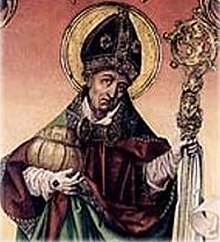Prince-Archbishopric of Salzburg
This article needs additional citations for verification. (May 2009) |
Prince-Archbishopric of Salzburg Archiepiscopatus Salisburgensis () | |||||||||
|---|---|---|---|---|---|---|---|---|---|
| 1328–1803 | |||||||||
Count Hieronymus von Colloredo (last) | |||||||||
| Historical era | Secularised to electorate | 1803 | |||||||
| 1805 | |||||||||
| Currency | Salzburg Thaler | ||||||||
| |||||||||
The Prince-Archbishopric of Salzburg (
From the late 13th century onwards, the archbishops gradually reached the status of
Geography

The prince-archbishopric's territory was roughly congruent with the present-day Austrian state of
.In the north and east, the prince-archbishopric bordered on the Duchy of Austria, a former Bavarian margraviate, which had become independent in 1156 and, raised to an archduchy in 1457, developed as the nucleus of the Habsburg monarchy. The Salzkammergut border region, today a UNESCO World Heritage Site, as an important salt trade region was gradually seized by the mighty House of Habsburg and incorporated into the Upper Austrian lands. In the southeast, Salzburg adjoined the Duchy of Styria, also ruled by the Habsburg (arch-)dukes in personal union since 1192. By 1335, the Austrian regents had also acquired the old Duchy of Carinthia in the south, the Styrian and Carinthian territories were incorporated into Inner Austria in 1379. The Habsburg encirclement was nearly completed when in 1363 the archdukes also attained the County of Tyrol in the west. Only in the northwest did Salzburg border on the Duchy of Bavaria (raised to an Electorate in 1623), and the tiny Berchtesgaden Provostry, which was able to retain its independence until the Mediatisation in 1803.
Previous history
The
Bavarian bishopric (c. 543/698–798)

From the sixth century onwards, the northern areas of the later archbishopric were resettled by
Rupert established a monastery dedicated to
Early archbishopric (798–1060)
Archbishop Adalwin (859–873) suffered great troubles when King
Soon after, the
Investiture era (1060–1213)
In the era beginning with
Prince-archbishopric


Archbishop Eberhard II of Regensberg was made a
King
In 1473, he summoned the first provincial diet in the history of the archbishopric, and eventually abdicated.[
Matthäus Lang was largely unnoticed in official circles, although his influence was felt throughout the archbishopric. He brought in
Archbishop
The last Prince-Archbishop,
Secularisation
In 1803, Salzburg was secularised as the
Up to today, the Archbishop of Salzburg has also borne the title
Bishops of Salzburg
- Rupert of Salzburg 696–716/18
- ...
- Virgil of Salzburg 746–784
- Arno of Salzburg 784–821
- Adalram 821–836
- ...
- Dietmar I 874–907
- Pilgrim I 907–923
- ...
- Gebhard of Salzburg 1060-1088
- Thiemo 1090-1102
- Conrad I of Babenberg 1106–1147
- Eberhard von Biburg 1147–1164
- Conrad II of Babenberg 1164–1168
- Adalbert III of Bohemia 1168-1177
- Conrad of Wittelsbach 1177-1183
- Adalbert III of Bohemia 1183-1200
- ...
- Philip of Spanheim 1247–1256
- Ulrich von Seckau 1256-1265
- Ladislaus of Salzburg 1265-1270
- ...
- Frederick III of Leibnitz 1315–1338
- Henry of Pirnbrunn 1338–1343
- Ordulf of Wiesseneck 1343–1365
- Pilgrim II of Pucheim1365–1396
- Gregor Schenk of Osterwitz 1396–1403
- Eberhard III of Neuhaus 1403–1427
- Eberhard IV of Starhemberg 1427–1429
- John II of Reichensperg 1429–1441
- Frederick IV Truchseß of Emmerberg 1441–1452
- Sigismund I of Volkersdorf 1452–1461
- Cardinal Burchard of Weissbruch1461–1466
- Bernhard II of Rohr 1466–1482
- John III Peckenschlager1482–1489
- Friedrich V of Schallenburg 1489–1494
- Sigismund II of Hollenegg 1494–1495
- Leonhard von Keutschach 1495–1519
- Matthäus Lang von Wellenburg 1519–1540
- Ernest of Bavaria 1540–1554
- Michael of Khuenburg 1554–1560
- John Jacob of Khun-Bellasy 1560–1586
- George of Kuenburg 1586–1587
- Wolf Dietrich von Raitenau1587–1612
- Marcus Sittich of Hohenems1612–1619
- Paris von Lodron1619–1653
- Guidobald of Thun 1654–1668
- Maximilian Gandalf of Kuenburg1668–1687
- Johann Ernst von Thun1687–1709
- Franz Anton von Harrach 1709–1727
- Leopold Anton von Firmian 1727–1744
- Jacob Ernest of Liechtenstein-Castelcorno 1744–1747
- Andreas Jacob of Dietrichstein 1747–1753
- Sigismund III of Schrattenbach 1753–1771
- Hieronymus von Colloredo 1772–1812 (last prince-archbishop, lost temporal power in 1803 after secularization)
See Roman Catholic Archdiocese of Salzburg for archbishops since 1812.
See also
- Alte Residenz– city palace
- Schloss Hellbrunn– summer palace
References
- ^ The Life of Saint Severinus by Eugippius trans. Robinson, GW. Oxford University Press, Oxford. 1914
- ^ Krause, Chester. Standard Catalog of World Coins 1701-1800, 1997, pp. 120-121.
- ^ The Methodist Review Vol. XLIII, No. 3, p. 305.
- ^ Christopher Clark, Iron Kingdom: The Rise and Downfall of Prussia, 1600-1947. Cambridge: Harvard University Press, 2006. pp. 141-143.


